Przeglądasz dział JEWELER MARKET (ENG) (id:115)
w numerze 01/2013 (id:114)
Ilość artykułów w dziale: 3
|
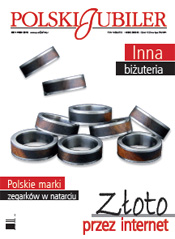
|
Recently, the Polish jewelry market witnessed the appearance of an unconventional and unusual jewelry that uses coal in its creations and is unknown in other parts of the world.
Coal has been mined in the Upper Silesia region since at least the mid-seventeenth century. Coal is a strategic resource in Poland, because it satisfies 60% of the energy needs of the country. The Polish resources of this rock are among the largest in the world. Most of them are located in the Lublin and the Upper Silesian Provinces.
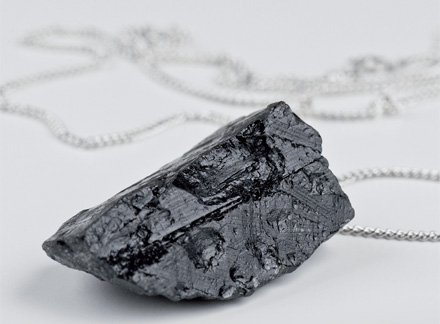
An idea for jewelery
Although coal has been embedded in Polish culture for centuries, the idea to create a collection of coal jewelry has only emerged recently. The idea was the brainchild of three designers: Bogna Polańska, Roma Skuza and Kaja Nosal, the co-owners of the Bro.Kat Studio. For years, coal was the material that one kept in basements. The Polish designers decided to explore its other face, assuming that the diamond is nothing but a correctly processed coal. At the same time, they linked their idea to a lifelong tradition of mining and processing the coal in Poland. It is worth noting that almost every coal mine boasted a coal sculptor, sculpting the statues of miners or Saint Barbara (miner’s patron saint). A unique collection of jewelry using the Hochglance coal, created by Bogna Polańska, Roma Skuza and Kaja Nosal is becoming increasingly popular among customers of jewelry showrooms and galleries in the country and abroad.
Coal and silver
The designers combine carbon with a typical Polish precious metal – silver. Although coal is a specific and very demanding material to work with when creating jewelry, the three designers managed to protect its surface in such a way that it became no different from other materials used to make jewelry. The coal jewelry is targeted to women who want to be elegant and express themselves through it in a unique way. The offer of the Silesian designers includes jewelry for both women (earrings, rings and unusual pendants) and men (cufflinks). Each piece of the collection is unique and made by hand. Each lump of coal, due to its being chipped of a larger block of stone has a unique shape. The jewelry is made of a fragile and “living” natural material, thus the impact or fall from a great height can cause chipping or scratching of the coal. Keep in mind that the material used in this jewelry is about three hundred million years old. Hochglance coal, created by Bogna Polańska, Roma Skuza and Kaja Nosal is becoming increasingly popular among customers of jewelry showrooms and galleries in the country and abroad. Coal and silv er The designers combine carbon with a typical Polish precious metal – silver.
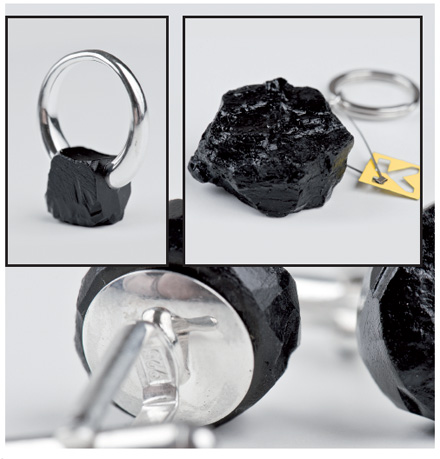
Although coal is a specific and very demanding material to work with when creating jewelry, the three designers managed to protect its surface in such a way that it became no different from other materials used to make jewelry. The coal jewelry is targeted to women who want to be elegant and express themselves through it in a unique way. The offer of the Silesian designers includes jewelry for both women (earrings, rings and unusual pendants) and men (cufflinks). Each piece of the collection is unique and made by hand. Each lump of coal, due to its being chipped of a larger block of stone has a unique shape. The jewelry is made of a fragile and “living” natural material, thus the impact or fall from a great height can cause chipping or scratching of the coal. Keep in mind that the material used in this jewelry is about three hundred million years old.
Striped flint is becoming Polish export merchandise. Jewelry made from the striped flint is now a Polish hallmark. It has appeared in the collections of the best recognized designers; the largest jewelry companies in the country now include it in their offer.
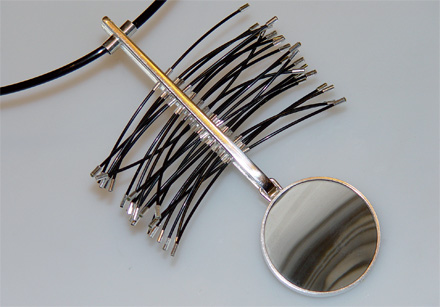
Striped flint can only be found in the Holy Cross Mountains (Góry Świętokrzyskie) in Poland. It is distinguished by the most beautiful and unique patterns. These patterns, when combined with the possibility of achieving a mirror-like luster, make the striped flint a valuable and eagerly sought-after resource on the jewelry market.
Precursor of Flint
The first artist to introduce striped flint in his jewelry was Cezary Łutowicz. In 1972, the first pieces of jewelry using this stone were created and flint turned out to be an excellent stone for making jewelry. Flint is very rare; it is decorative and extremely hard – it reaches up to the level of 6.7-7 on Mohs’ 10-level hardness scale, where 10 is the hardness of diamond. Cezary Łutowicz participated in several group and individual exhibitions, for example, in Vienna, Munich and Brussels. His creations became an inspiration for many artists and striped flint jewelry can now be found in jewelry stores and art galleries showing artisan jewelry in Poland and abroad.
The works of the master jeweler delighted with their individuality and were the object of interest of not only women but also the press and television. Jewelry made from striped flint is very popular among customers. As experts point out, flint jewelry is distinguished by its elegance – its gray color perfectly matches almost any fashion design.
Gold smith’s Art Collection
In the year 2000, goldsmith workshops titled “Striped flint – the stone of optimism” were organized for the first time in Sandomierz aiming to promote striped flint as the Polish raw material native only to Sandomierz and to create a unique museum collection of striped flint used in jewelry and objects of art. Through the workshops, the Sandomierz Regional Museum has acquired more than two hundred works of recognized artists for permanent display. It is the only such collection in the world. The Sandomierz collection is an open and very diverse exhibition. There, you will find examples of classic jewelry as well as small sculptures, objects and installations.
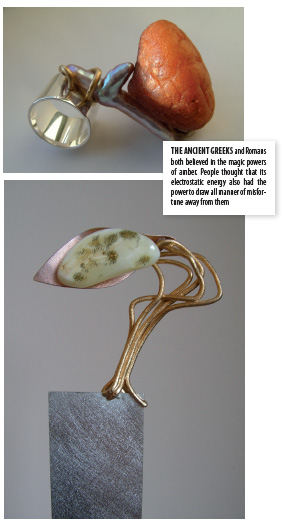 Modern amber
Modern amber
Polish jewelry is mainly associated with amber and silver. It is not surprising that the “Polish national treasure” wins the hearts of not only Polish women but also women looking for unique jewelry all over the world. Therefore, manufacturers and designers of amber jewelry are striving to surprise their customers and also offer them unusual forms of jewelry, designed to meet the requirements of discerning customers.
Tradition and fashion
Until recently, amber jewelry was primarily associated with necklaces and bracelets. But designers and manufacturers were quick to note that both Polish and foreign guests want to it to be not only beautiful but also unique. Amber artisans came forward to meet the expectations of customers and began to create jewelry that met the requirements of almost all customers. Amber studios started selling short series or single specimens of jewelry. The design of amber jewelry started to develop and has been experiencing a dynamic development. There are numerous companies on the Polish market that specialize in creating jewelry made of the “Polish national treasure.” Amber designers are very sensitive to market needs, quickly adapting their collections to the current market trends and thus to the expectations of the contemporary customer.
 Any trend change among the customers of jewelry showrooms is reflected in the subsequent collections of amber jewelry. We must not forget, however, that amber artisans besides adapting their products to meet the expectations of discriminating customers also attempt to create fashion themselves and to break the stereotypes associated with amber. The new collections of large companies specializing in the production of amber jewelry now include jewelry combining amber with gold, striped flint, turquoise, coral and pearls. Amber artisans have abandoned the previously almost inseparable combinations of amber and silver. With their innovative designs, the creators of amber jewelry strive to surprise their customers and make the amber became a fashion accessory. Nearly every company on the Polish market is trying to introduce their own original solutions; thus they opt for interesting combinations of amber and precious and semiprecious stones. The task that these artisans establish for themselves is to create unstructured and unique work of art.
Any trend change among the customers of jewelry showrooms is reflected in the subsequent collections of amber jewelry. We must not forget, however, that amber artisans besides adapting their products to meet the expectations of discriminating customers also attempt to create fashion themselves and to break the stereotypes associated with amber. The new collections of large companies specializing in the production of amber jewelry now include jewelry combining amber with gold, striped flint, turquoise, coral and pearls. Amber artisans have abandoned the previously almost inseparable combinations of amber and silver. With their innovative designs, the creators of amber jewelry strive to surprise their customers and make the amber became a fashion accessory. Nearly every company on the Polish market is trying to introduce their own original solutions; thus they opt for interesting combinations of amber and precious and semiprecious stones. The task that these artisans establish for themselves is to create unstructured and unique work of art.
Collections of the companies involved in amber processing include numerous kinds of pendants, beads and charms which have been bestsellers recently. Polish artists and jewelry manufacturers turned out to be the precursors of style; they were able to make their original designs recognized all over the world.
Silver and more
When creating amber jewelry, the Polish designers primarily focus on silver. Silver is inseparably associated with amber, and thanks to silver, artists creating in metal bring out the natural beauty of the Baltic treasure. In the studios of Polish masters, a unique silver jewelry is being created, “tailored to” modern women. Some designers create their jewelry using gold. Designers also attempt to use white gold, which perfectly matches amber and does not break with the traditional perception of amber jewelry. Moreover, it is worth noting that the Polish market also offers amber jewelry combined with wood or even plastic. Wooden jewelry including amber is very popular – it is not only aligned with the latest environmental trends but it also emphasizes the aesthetic qualities of amber. Amber is also freely combined with leather, silk, wood and cotton rope. Amber beads and necklaces are often comingled with semi-precious stones (turquoise), pearls, crystal, gilt silver, ebony and red reef coral. Amber has come into the fashion; amber jewelry is often presented in fashion shows and celebrities are happy to wear it – perhaps because it is so universally applicable. The current clear trend is to move away from the previous homogeneous image of amber jewelry: a traditional, typically oval cabochon in a silver frame. Nowadays, a clear distinction is emerging between a commercial jewelry – by definition a low-cost made using a simple technology – and the artisan jewelry made by its creator: the jewelry that enjoys the best recognition and which must wait for its buyer.
Polish jewelry market is valued by experts at around 1.5 billion US dollars per year. Poles spend their money to buy jewelry which they regard not only as beautiful and valuable items or capital investment, but also as an investment in the contemporary art. More recently, the jewelry market has been undergoing significant changes which prove that jewelry showroom customers have considerable interest in purchasing costly luxury items.

Jewelry is sold both in specialty stores – private and corporate showrooms – and in gift shops, souvenir stores and on markets. Distributors and wholesalers are also active in the market. Gold jewelry is the bestseller in Poland. It is estimated that in 2011, gold jewelry constituted 60% of the market, with the silver jewelry in the second place. Poland is the third producer of silver in the world. It is also a major exporter of amber and a sole exporter of striped flint.
The Largest Players in the Market
The 2012 KPMG report “The Luxury Goods Market in Poland” shows that 751,000 people reached the gross monthly income of over EUR 1,700 in the country, which represents almost 23,000 more than in 2011 and roughly 90,000 more than in 2010. This recently observed upward trend is likely to continue, and in 2015 Poland may reach approximately 840,000 rich and affluent people whose total annual income will be close to EUR 40 billion. It is estimated that in Poland, approximately 10,000 businesses operate in the goldsmith and jewelry market, with as much as 90% of them functioning as small, family-run businesses employing fewer than nine people. About 95% of goldsmith and jewelry companies in Poland are located in cities and towns. Additionally, 50% of medium and large jewelry companies choose to operate in small towns. It is obvious that the reason for the concentration of jewelry stores (especially the small ones) in specific areas is their proximity to the goods markets.
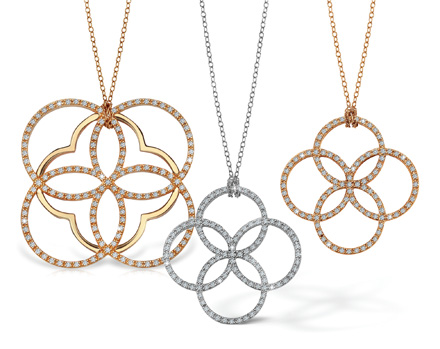
 Apart, YES and W. Kruk are the three largest companies operating on the Polish jewelry market. The Apart jewelry company has more than 183 showrooms in Poland. It employs more than 1,800 people and is an indisputable leader of jewelry sales in Poland. Besides the usual showrooms, the Apart Company also sells jewelry at Apart Exclusive – its most luxurious show rooms. There, customers can find jewelry containing diamonds and other precious stones as well as masterpieces of renowned Swiss watch brands. The W. Kruk jewelry company and the YES jewelry stores are equally trusted by the customers. The W. Kruk jewelry company has more than 70 showrooms and YES offers its customers jewelry in 100 showrooms. The YES Jewelry provides funds for the YES Gallery which presents the masterpieces of Polish artists, designers and master goldsmiths. Moreover, it creates and supports – as the organizer and sponsor – art events promoting contemporary Polish art. Jewelry sold by the largest jewelry companies in Poland is very popular among Poles, not only because of its undeniable aesthetic value, but also because of the opportunity to buy jewelry bearing logos of the largest companies in the jewelry world in their showrooms. It is estimated that the three largest jewelry companies enjoy more than 60% market share of jewelry sales in the country. When shopping at the brand jewelry stores, Poles usually decide to buy diamond rings and wedding rings and they typically spend no more than PLN 3,000. Companies that – besides selling jewelry – are also involved in its manufacture and stand out among the competition because of their interesting designs are particularly note- wo r – thy. Of these, Górecki, Aren Jeweler, Luxoro, Jubiler Schubert, Natalia Gold and S&A Jewellery Design deserve honorable mention. These companies are increasingly active in attempting to establish their position in the market by offering unconventional designs and interesting technological solutions used to create jewelry.
Apart, YES and W. Kruk are the three largest companies operating on the Polish jewelry market. The Apart jewelry company has more than 183 showrooms in Poland. It employs more than 1,800 people and is an indisputable leader of jewelry sales in Poland. Besides the usual showrooms, the Apart Company also sells jewelry at Apart Exclusive – its most luxurious show rooms. There, customers can find jewelry containing diamonds and other precious stones as well as masterpieces of renowned Swiss watch brands. The W. Kruk jewelry company and the YES jewelry stores are equally trusted by the customers. The W. Kruk jewelry company has more than 70 showrooms and YES offers its customers jewelry in 100 showrooms. The YES Jewelry provides funds for the YES Gallery which presents the masterpieces of Polish artists, designers and master goldsmiths. Moreover, it creates and supports – as the organizer and sponsor – art events promoting contemporary Polish art. Jewelry sold by the largest jewelry companies in Poland is very popular among Poles, not only because of its undeniable aesthetic value, but also because of the opportunity to buy jewelry bearing logos of the largest companies in the jewelry world in their showrooms. It is estimated that the three largest jewelry companies enjoy more than 60% market share of jewelry sales in the country. When shopping at the brand jewelry stores, Poles usually decide to buy diamond rings and wedding rings and they typically spend no more than PLN 3,000. Companies that – besides selling jewelry – are also involved in its manufacture and stand out among the competition because of their interesting designs are particularly note- wo r – thy. Of these, Górecki, Aren Jeweler, Luxoro, Jubiler Schubert, Natalia Gold and S&A Jewellery Design deserve honorable mention. These companies are increasingly active in attempting to establish their position in the market by offering unconventional designs and interesting technological solutions used to create jewelry.
Desig n and Masterpi eces of the Gold smit h’s Art
Jewelry purchases are not made only “at a jeweler’s.” The KPMG research shows that in Poland, the majority of luxury goods buyers choose showrooms which sell only the single-brand products. In the next group, 39% are the customers who frequent the department stores where they have a greater selection of different brand products under one roof.
Equally popular are websites dedicated to luxury shopping. In Poland, customers are increasingly likely to buy jewelry at art galleries where they can find jewelry made by the best Polish jewelry designers in one place. Consumers have become more discerning and want the jewelry they purchase to be not only made of the most expensive metals in the world but also to represent miniature masterpieces of the goldsmith’s art. The increasingly financially comfortable Poles are eager to look for luxury items whose market value will multiply over time. A growing consumer interest in the jewelry offered in artisan jewelry galleries seems to be the proof. At artisan jewelry galleries, customers may find products made by both the Academy of Fine Arts professors, wellknown and respected goldsmith artists and young artists who are making their debut on the Polish art market. The most respected artists whose artistic jewelry is available in such galleries are Marcin Tymiński, Jacek Byczewski, Cezary Łutowicz, Mariusz Gliwiński, Paweł Kaczyński, Arkadiusz Wolski, Piotr Małysz and Andrzej Bielak. The works of these artists are known not only on the Polish art market but are also award-winning masterpieces of international goldsmith competitions. Almost every major city boasts galleries of artisan jewelry made by in-house artists. Among those, Bożena Marka’s Gallery in Warsaw, Techne Gallery in Poznań, RA Gallery in Cracow, Nowińska Gallery in Warsaw, Gold & Silver Gallery in Sandomierz and Bielak Gallery in Cracow are particularly worth mentioning. Customers frequenting such galleries are interested in handmade silver jewelry, often containing amber and striped flint used in manufacturing. Customers are also willing to choose jewelry pieces made of gold and precious stones despite the fact that for an average Pole the price for gold rings made by a goldsmith artist is relatively high. In Poland, one may notice a need for individualized jewelry, as so far evidenced by a great success of the Pandora jewelry in our market, which offered customers the opportunity to combine the jewelry pieces themselves, and the native Lilou brand jewelry. Both the economic crisis and the customers seeking genuine valuables led Poles to decide to also buy “antique” jewelry. Poland is experiencing the emergence of a secondary jewelry market due to the customer focus on jewelry. Customers increasingly choose purchasing jewelry at art auctions. The prices of the jewelry sold there reach over PLN 100,000. Investors are looking for art deco jewelry which may prove ideal capital investment. The constantly rising prices of precious metals and stones make the Poles want to invest their money in the precious old jewelry. Jewelry showrooms customers treat jewelry as an investment. A report published by KPMG shows that Poles are equally willing to invest their money in jewelry and in real estate. They also frequently spend money on works of art, which also speaks in favor of jewelry.
Jewelry Show room Customers
Customers of jewelry showrooms and art galleries in Poland can be divided into two groups. On the one hand, they are young, well-paid women who tend to be residents of large cities. They look for jewelry that will allow them to manifest their style and emphasize their personality. Then there are affluent people over forty, who treat jewelry as an investment and also as an opportunity to emphasize their financial status. This group also includes a slowly increasing number of men who are interested in buying men’s jewelry. Most often, they choose the valuables bearing logos of well-known jewelry brands. The second group includes first of all the customers who are interested in buying wedding jewelry – the engagement and wedding rings. They do not spend a lot of money to buy jewelry – they do not spend more than PLN 1,000 on their purchases – but according to research, they constitute a stable group of customers of Polish jewelry showrooms.
Amber and striped flint
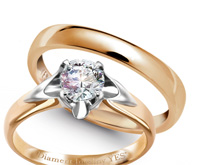 Polish jewelry is inherently associated with amber. Artists dealing with amber continuously offer beautiful specimens of jewelry to their customers. The design is becoming increasingly more attractive and works by Polish designers emphasize the individual appeal of amber. Designers disc o v e r t h e “Polish national treasure” themselves and thus for the customer as well. There is a growing group of customers with s o p h i s t i c a t e d tastes, consciously seeking and appreciating the individual forms of amber. However, we must remember that Poland is not only amber, but also striped flint. Jewelry made from striped flint wins a larger group of enthusiasts each year. Flint jewelry has been shown throughout Europe, India and Asia and everywhere it awakened interest in the stone. Amber has been known for thousands of years and can be found in all the Baltic countries, but flint is different; there is only one place on earth where it is found: in Sandomierz. Sandomierz was proclaimed “The World Capital of Striped Flint” and a lot of tourists go there following that stone. The city created shops, galleries as well as processing and promotional places of this mineral “rarer than diamond” .
Polish jewelry is inherently associated with amber. Artists dealing with amber continuously offer beautiful specimens of jewelry to their customers. The design is becoming increasingly more attractive and works by Polish designers emphasize the individual appeal of amber. Designers disc o v e r t h e “Polish national treasure” themselves and thus for the customer as well. There is a growing group of customers with s o p h i s t i c a t e d tastes, consciously seeking and appreciating the individual forms of amber. However, we must remember that Poland is not only amber, but also striped flint. Jewelry made from striped flint wins a larger group of enthusiasts each year. Flint jewelry has been shown throughout Europe, India and Asia and everywhere it awakened interest in the stone. Amber has been known for thousands of years and can be found in all the Baltic countries, but flint is different; there is only one place on earth where it is found: in Sandomierz. Sandomierz was proclaimed “The World Capital of Striped Flint” and a lot of tourists go there following that stone. The city created shops, galleries as well as processing and promotional places of this mineral “rarer than diamond” .

















